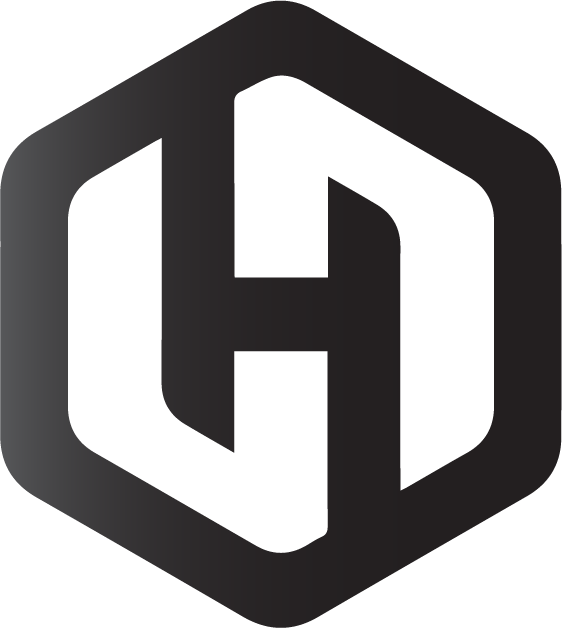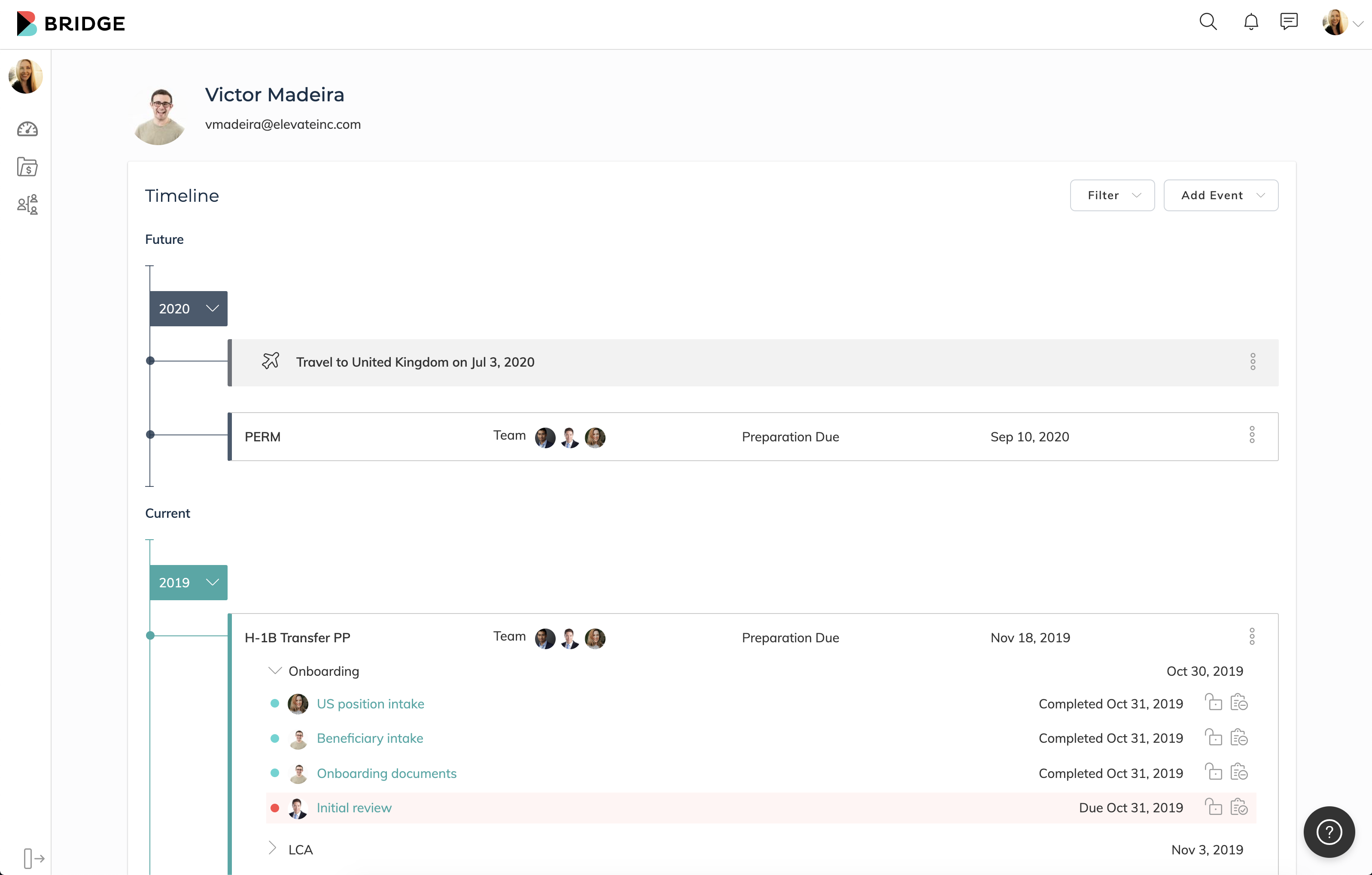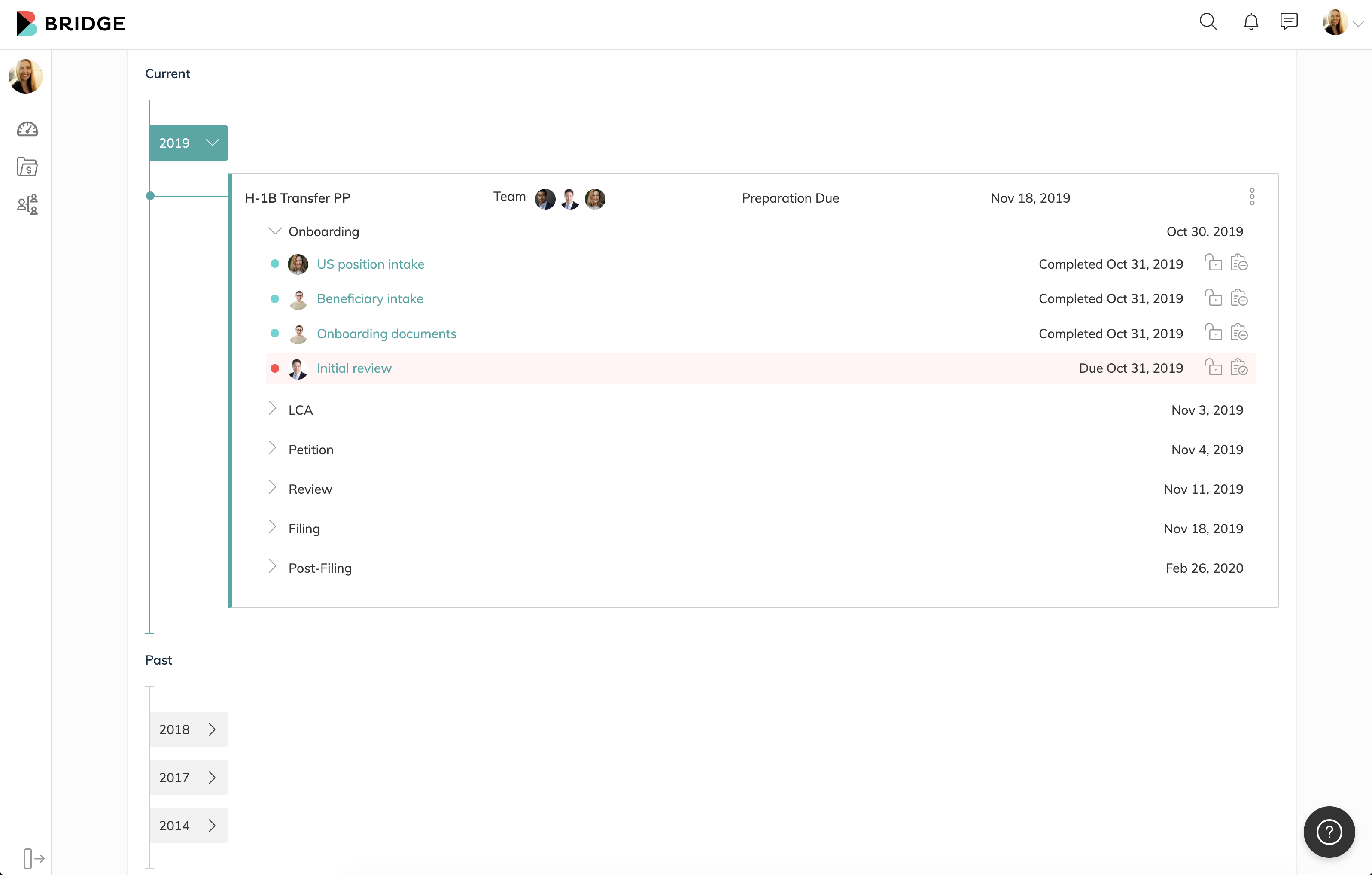
Changing Immigration Forever
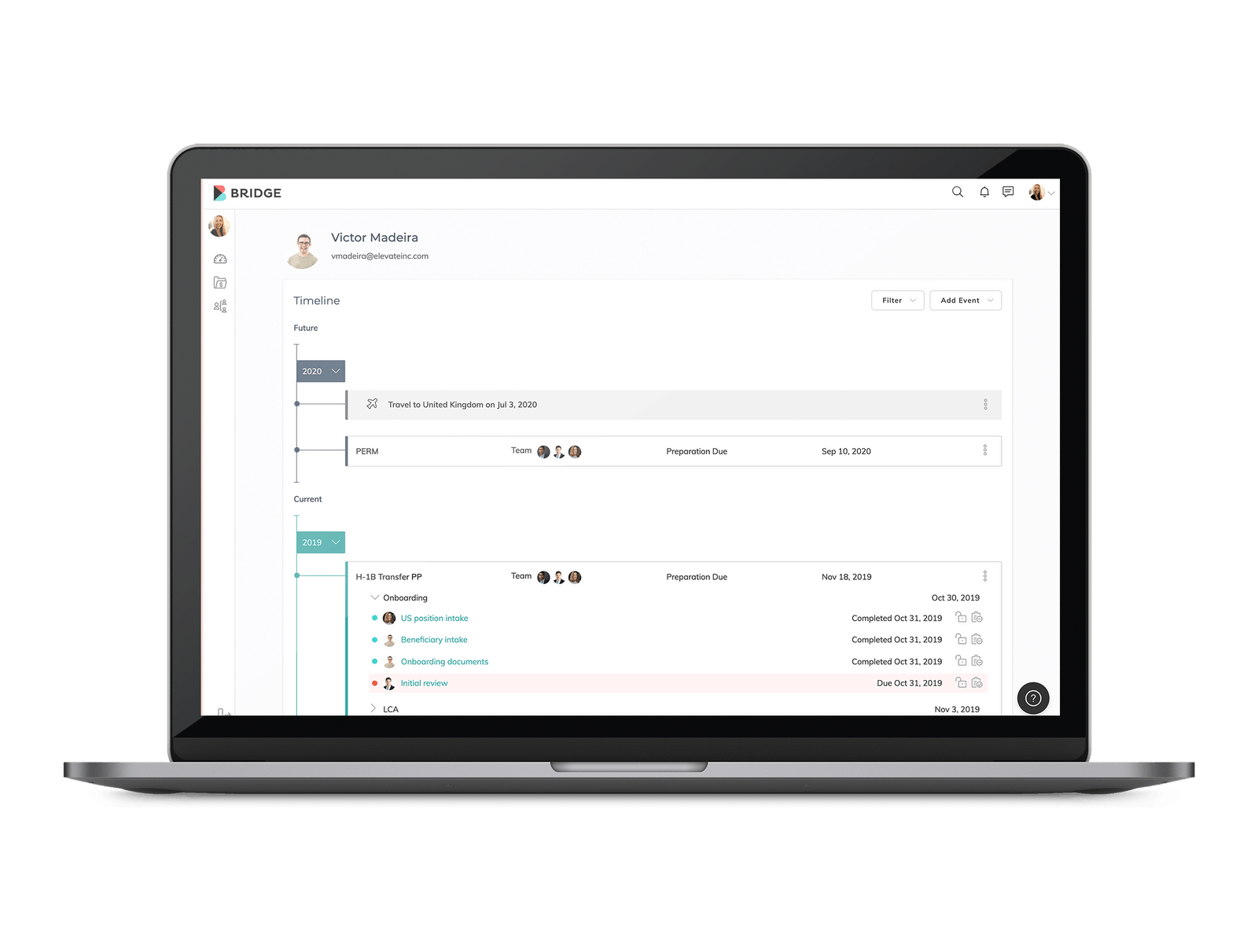
Bridge is a purpose-built technology platform that automates and reimagines traditional immigration processes for foreign nationals, managed HR representatives and Attorneys. Bridge offers a full-service solution managed by an in-house client services team, as well as a standalone SAAS solution.
- Product Design (Web, SAAS, Mobile)
- Design System
- Branding
Tools
- Figma
- Storybook
- Adobe CC
- Confluence
- Clickup
- Heap
Employed
June 2019 – Present
Product Design
Upon joining Bridge in June 2019, I was the first product designer on the team and it remained that way during my tenure at Bridge. As the sole designer on the team, I took on a full-stack role in managing all aspects of design for the product. Prior to my joining, stakeholders hired contract designers to help solve design problems.
I joined Bridge at a crucial inflection point. It was a milestone in the growth, the product team was beginning to work on the ‘launch’ or re-launch, an unveiling of the immigration platform re-imagined.
In my first week at Bridge, I was tasked with reimagining the existing immigration platform. Our long term goal was and still remains for Bridge to be a global immigration hub. Understanding that greatness cannot be achieved overnight, we directed our attention to create the International Employee (IE) Profile that consisted of a timeline showcasing an IE’s immigration history and their path to citizenship.
My joining of the company was coupled with the hiring of a Marketing guru consultant that overhauled Bridge’s entire brand and values.
Problem
I recall vividly during my first week at Bridge, my direct manager, Forrest Blount, who also happens to be the CTO of the company asked me whether I’d prefer to take it easy during my onboarding to learn the industry and the work that we do, or jump right it in and learn as I go. I chose to jump right it in.
Via email, I received the first problem we were looking to solve. In Forrest’s description of the problem, he expressed the need for the Bridge platform’s growth beyond application workflows, which in the product’s previous state was the focus. He spoke of a timeline, reminders, and better organization. Though not blatantly expressed in the email below, Forrest was describing a need for a profile for international employees, a hub for their immigration processes – a direction of growth into much more.
”Our current timeline is embedded in a matter and extends until the last date entered within that matters, often an FN expiration date or a Target Filing Date.
In addition to tracking the key due dates within a matter, we'd like to have a timeline that could extend to include additional events from the FN’s journey, including prior visas, travel, and future renewals, petitions, green cards, etc.
One of the elements that we would like to include in the FN timelines are Reminders set in the future. These Reminders are set to bookmark when a future process (e.g. a visa renewal) should be considered.
While considering the above, some challenges should be considered:
Forrest BlountCTO
Our current timeline represents the Date that tasks are completed or, if the task is not yet completed, the Date the task is due. This sometimes causes tasks and milestones to change position because they are completed in a different order. Is there a way to organize our Timeline that will be consistent regardless of when tasks are completed?
While the Milestones we use to enclose individual tasks are useful if you're familiar with them, the number of elements involved, and the need to expand them to see which tasks they contain, lead me to believe that they aren't often expanded and explored by our HR and FN users. Is there a better way to arrange our Timelines to accomplish our goal of providing a transparent map of our matters?
* Definitions: FN = Foreign National or International Employee, Matter = Immigration Application
The image below is what Forrest was describing in his email. It’s a screengrab of a matter (application), the main focus of the product interface, and essentially what the product looked like when I joined Bridge.
The timeline Forrest spoke of was centered around the application. The application was displayed to the user in a timeline. Within the timeline were milestones, categories that contain tasks by which Bridge identified as the most effective and efficient method of visa application processing.
Tasks within each milestone are assigned to a user. The tasks would be accessed from this screen and needed to be completed by a determined date in order for the collective application to meet its target filing date.
The target filing date is always driven by a principle date in which is a hard deadline to file an application. For example, H-1B target filing dates are mostly driven by an IE’s start date at a new job, or if it’s a renewal, before the expiration of the visa. The calculations and the circumstances for each application are immensely complex, hence the importance of the organization and the future context for applications.
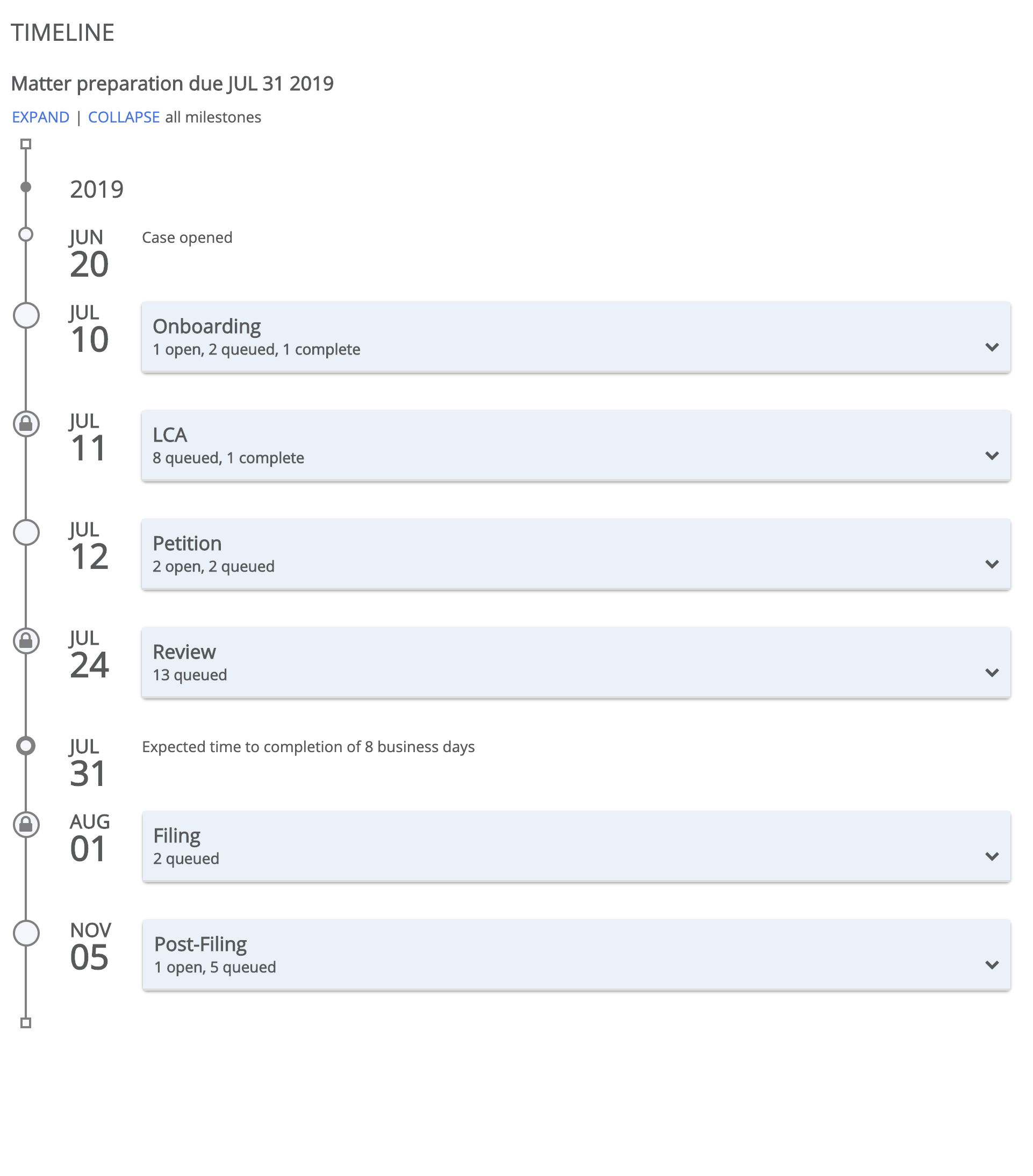
Research
One of the most important phases of product design is actually done before the design process even starts. Before you start building a product, you need to understand its context for existence. It’s the time when the product team must define the product vision and product strategy.
In this case, we have business goals and a problem defined and they were directly handed down by the CTO of the company. Stakeholders at Bridge we profound in the defining direction and vision for the company. From the start, we knew where we wanted to go, it was only a matter of getting there.
We needed context and a strategy to make the vision reality.
Who
To solve the problem above, the first step in my design process was to understand who we’re solving the problem for. Bridge has four primary user-roles, all of whom use the product for different use-cases, but generally the same purpose.
Client Services Team
The Client Services Team are Bridge employees, they oversee every application and play a crucial role in the product. The Client Services Team is the face of Bridge and they work very closely with all the other users on Bridge – HR Representatives, the Legal Team, and International Employees.
They are the platform’s admins that oversee the application processes and ultimately the ones who ensure timely and accurate application submissions on the Bridge platform, not only on behalf of International Employees but also the company that is looking to hire them. Their day-to-day workflow is centered around the complex, nitty-gritty processes for applicati0ns and companies. They are the gatekeepers, they are responsible for successfully processing application and monitoring that application deadlines are met.
Human Resources Team
Human Resouces users are company representatives and their role is to manage potential and hired talent on behalf of their company. Bridge views companies as clients, we work hard to win their business and likewise to maintain it by offering a set of tools relatively unavailable anywhere on the market. The general HR user wants to verify the immigration eligibility of potential talent, hire international eligible talent, and maintain their immigration status. During my tenure at Bridge, we developed further tools for HR users, but these are the general use-cases that make Bridge a viable resource for companies.
Legal Team
The Legal Team are Bridge partners whose role is to review and verify eligibility, often attributing the success rate of visa application approvals at Bridge. The Legal Team are experts in Immigration Law, they are able to piece together the most acceptable application parameters to successfully place an International Employee in their desired role. They identify loose ends and advise accordingly. They also play a crucial role in the submission of applications once everything is completed by the Client Services Team.
International Employees
The Bridge platform is centered around International Employees. They come from all backgrounds from all around the world. Their talent is pursued by companies looking for the best and the brightest. Their role on the Bridge platform is to provide necessary information for their visa application. During my tenure, we expand on this and look towards IE’s as part of a larger global vision, but initially, their contribution to the application is minimal.
What
To determine our focus, I first had to break down the dense definition of the problem I was looking to solve from Forrest’s email. You can imagine the sheer magnitude of questions that came thereafter. Not only was I new to the company, but the task at hand was rather vast in scope.
-
✅ From one event (i.e. matter) to multiple
- ✅ A timeline that includes current, past, and future events.
- ✅ Introduction of Reminders
- ✅ Date Driven Organization and Consistency
- ✅ Better Usability
- ✅ Better Process Transparency
- ✅ A Task-Oriented Application Process
How
Once I unraveled the “what” from the defined problem, coupled with the understanding of “who” the users are, I was able to start contemplating how it can be done.
This process normally more in the creative process, however, there was a structural inconsistency in the Stakeholders’ vision and the reality of the product. On the one hand, the previous timeline was heavily centered around the application and on the other, we wanted to add more ‘events’ to it.
Utilizing a mindmap, I discovered that structure of the previous timeline had a major hierarchical problem, and that was that the epicenter of the platform’s design was actually not supposed to be centered around the application, but rather the International Employee. I discovered that every element of the Bridge platform and processes always point back to the International Employee.

Another major flaw that Forrest’s email was alluding to was the previous interface’s experience. Forrest mentioned that he suspects that users are not utilizing the timeline as expected and hardly clicking into milestones within the timeline to reveal tasks.
In my analysis of this problem, I discovered that international employees hardly had tasks to contribute to the overall application. If you take all the tasks required to successfully complete an application, though each application differs, the approximate total share in the workload of an application is 20% for the international employee. Their role is solely to provide information and prove their elegibility. Therefore, the application interface is not really meant for their user-role, we would provide access to the process to adhere to one of Bridge’s core values. transparency.
Another important finding hindering the overall experience and usability of the platform was the overwhelming legal terminology used. While Bridge is a legal tech product, we weren’t doing a good job of isolating the user from terminology complexities and making it easier for them. One immediate way to do this was to translate what some of the confusing terms actually mean. For example, foreign nationals mean employees, and matters mean applications. There was no reason to actually use government terminology other than please lawyers, yet they as we do serve immigrants and that should remain the focus.
Though I did not speak of everything we worked on to get to the first iteration, these were highlights and turning points for Bridge. They are what shaped this application’s growth trajectory for the long run.
Why
The most important part of any proposed solution will always be the whys. Design decisions are ultimately proposals and proposals like everything else in the professional world must embody a value. In our case, we ask ourselves, does the proposed direction translate well the business goals to experience, and is the best imminent way forward, allowing growth and better usability?
Well, yes it does. As the hierarchical mapping illustrates, applications are not on top of the food chain, rather it is the International Employee. The International Employee is centered around all the work Bridge does and likewise is the argument for the platform. If we focus on any other user role and base our design decisions on them, this would platform would shift from the slated business goals and broader vision defined by Bridge’s Stakeholders.
Now that we understand why we focus on the International Employee user-role as a base for our design decisions, we must also understand the why behind our strategy to build an experience worthy of the slated business goals. Our underlying strategy is to create a profile page for the IE user.
Our business goals state that we want to create a timeline that can house a broad range of events, from applications to informational sections. Also, to introduce reminders and tasks module. This user experience allows to better solve the problems stated by Forrest in respect to better usability and experience, better process transparency, and data-driven organization and consistency because the entire realm of the platform shifts in focus.
Solution
One of the most important phases of product design is actually done before the design process even starts. Before you start building a product, you need to understand its context for existence. It’s the time when the product team must define the product vision and product strategy.
In this case, we have business goals and a problem defined and they were directly handed down by the CTO of the company. Stakeholders at Bridge we profound in the defining direction and vision for the company. From the onstart, we knew where we wanted to go, it was only a matter of getting there.
We needed context and a strategy to make the vision reality.
Beyond
The introduction of the Immigration History Profile & Timeline was the very first large project I owned working at Bridge. Thereon, we accomplished slue of larger projects with one larger vision in mind: the Bridge Immigration Platform.
User Dashboard for HR Representatives, Client Services & Attorneys
The Client Services Team are Bridge employees, they oversee every application and play a crucial role in the product. The Client Services Team is the face of Bridge and they work very closely with all the other users on Bridge – HR Representatives, the Legal Team, and International Employees – dubbed admin users.
The platform’s admins oversee the application processes and ultimately the ones who ensure timely and accurate application submissions on the Bridge platform, not only on behalf of International Employees but also the company that is looking to hire them. Their day-to-day workflow is centered around the complex, nitty-gritty processes for applicati0ns and companies. They are the gatekeepers, they are responsible for successfully processing applications and monitoring that application deadlines are met. It was of the utmost importance that the next wave of upcoming available resources was dedicated to enhancing admin users’ experience.
Being that admin users’ day-to-day workflow revolves around processing time-restraint tasks. It was important to produce a dashboard that was unique to their key jobs, allowing the users to effectively track, complete and schedule tasks.
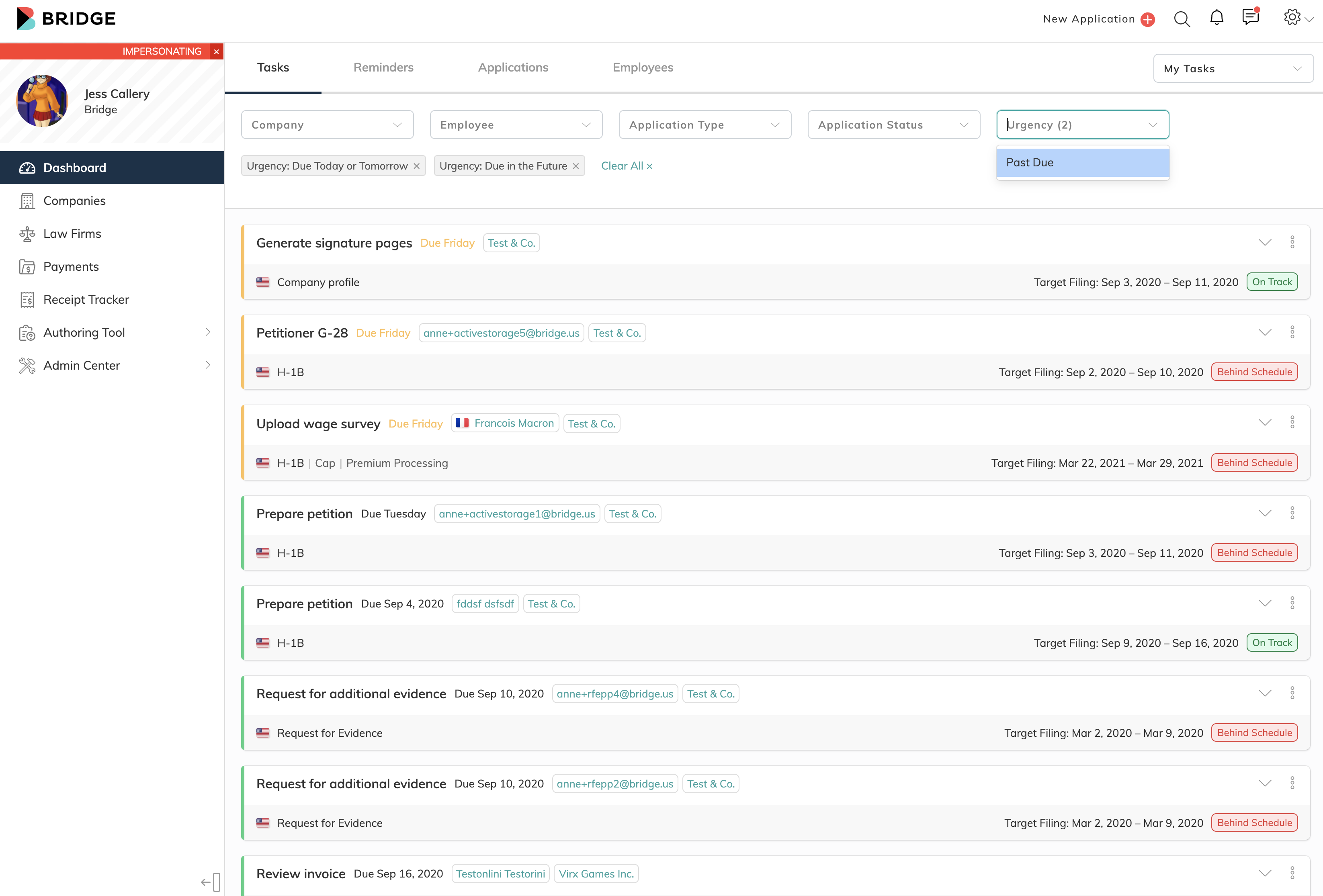
Strategy & Immigration Guidelines
While our Client Services team is an in-house team at Bridge and Attorneys are partner law firms, HR Representatives are users whose company is an acquired client that look to Bridge as a solution for a slue of frustrations within the immigration process. HR Representatives are users who use Bridge to make it easy to acquire foreign talent, manage their applications, and ensure the talents’ tenure at the company.
Strategy and Immigration Guidelines are bundled tools for HR Representatives and in general, companies that help them achieve their hiring needs. Immigration Guidelines allow HR Representatives to set up guidelines for their employees in regards to fees, renewals, and green card applications – allowing users to projet applications and process them according to what makes the most sense for their employees and the company. Additionally, the setting up of these guidelines allows the Bridge app to project future applications so that they are kicked off automatically customized to the employee’s needs and allows companies to measure all open and projected application types. In conjunction, Strategy works with Immigration Guidelines to budget and access a cost analysis tailored to the company’s immigration program. These tools geared towards improving a rigorous process of immigration projection help HR representatives do their work smarter and more efficiently work. Prior to this initiative, HR Representatives were tracking these metics and plans in an excel spreadsheet. These kinds of tools are virtually unavailable on the market for immigration. Our success lies in identifying these pain points and producing the technology the poses the solution. This one way how Bridges has become the immigration hub for employers.
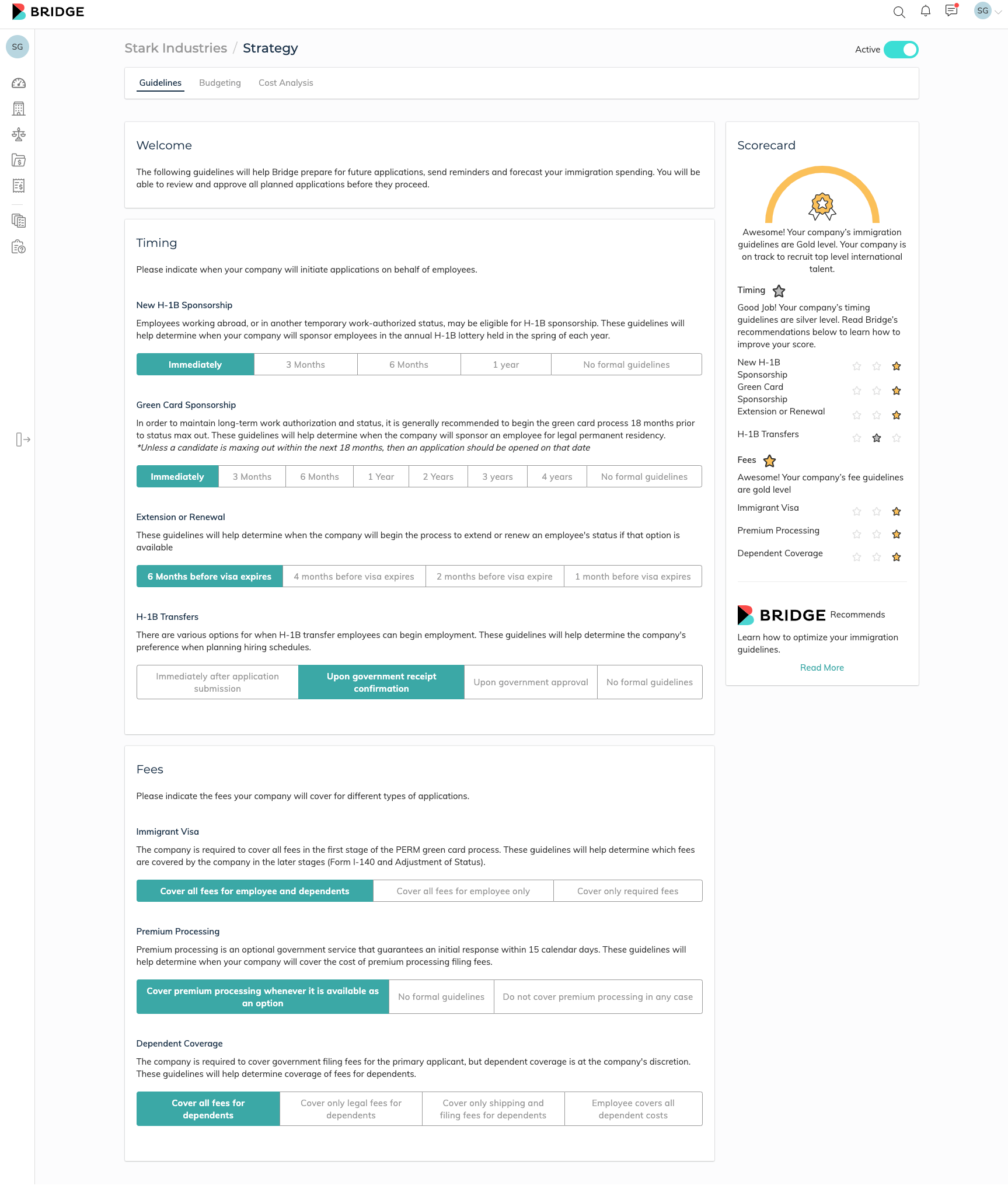
Invoicing
The Product Team also took the time to build out a robust invoicing system for Bridge users. Invoicing helped solve another frustration in the immigration process. Invoicing helps keep billing automated and efficient.
Billing Procedures:
-
- Employees billed for the portion of their application fees (depending on the Company’s Immigration Guidelines)
- Company’s billed by Bridge per application for application-related fees
- Attorney Partners billing Bridge for their application-related fees
Our invoicing made billing automated depending on application parameters and company guidelines. In addition, a dashboard was constructed to organize this information. Companies can automatically approve certain types of invoices and manually pay others. They could also keep track of what’s paid, what’s upcoming, and what is due. Additionally, they are able to access history to access costs per employee, division, and duration.


